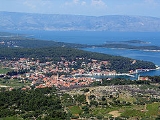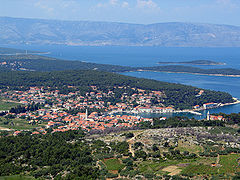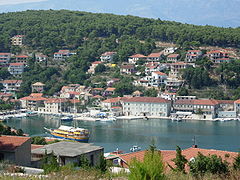
Jelsa, Croatia
Encyclopedia
Jelsa is a town in Croatia
, on the island of Hvar
. Jelsa is also a district (Općina) within the county of Split-Dalmatia
.
, Pitve, Poljica, Prapatna, Pokrivenik, Svirče, Vela and Mala Stiniva, Vrboska
, Vrisnik, Zastražišće and Zavala. (Ref: 2009 Jelsa Općina website)
On the mountain spur overlooking Jelsa to the south, is the massive fortress of Tor, which was a Greek observation point, standing on an older Illyrian fort (4th–3rd century B.C.). The location is an ideal defensive position as it overlooks the islands of Hvar and Brač as far as Šolta and the Makarska coast. Demetrius of Hvar reigned here for some ten years until the Roman occupation.
Slightly further eastwards, the fortress of Grad (or Galešnik) stands on a high cliff above the ancient road leading to the eastern end of the island. Originally Illyrian, the fort was further developed in Roman times, and still inhabited during the early Middle Ages. Its present name is believed to derive from the nobleman Galeša Slavogosti, who led an unsuccessful rebellion against Venice, in 1310, using this fortress as his stronghold.
 The present town of Jelsa was founded as a port for the village of Pitve in the 14th century. The 1424 Statute of Hvar mentions it as being 3 km from the sea, under the hill of Gozd, in the quest for sea and fishing, and having good fresh water (Portus de Pitue, p. 202, fons vocata Ielsa qui est prope mare, pp. 50 i 51, ad Ielsa usque ad ripam maris, p. 46, itd.). The first houses were built around the church of Sv. Mihović (St Michael) at Mala Banda on the northern side of the bay. A further group of houses developed on the south shore, around the church of Sv. Ivan (St John).
The present town of Jelsa was founded as a port for the village of Pitve in the 14th century. The 1424 Statute of Hvar mentions it as being 3 km from the sea, under the hill of Gozd, in the quest for sea and fishing, and having good fresh water (Portus de Pitue, p. 202, fons vocata Ielsa qui est prope mare, pp. 50 i 51, ad Ielsa usque ad ripam maris, p. 46, itd.). The first houses were built around the church of Sv. Mihović (St Michael) at Mala Banda on the northern side of the bay. A further group of houses developed on the south shore, around the church of Sv. Ivan (St John).
From fishing and agriculture, Jelsa developed into a shipbuilding and maritime centre, especially during the 19th century. The town prospered, and became the administrative capital for the central district of the island of Hvar. The port and break-waters were begun around 1830, after which the reclamation of marshy land started, and the town park was created. On the seafront next to the town, the town council building and town hall were built.
 Founded originally as the port for the community of Pitve, Jelsa grew in importance over the centuries. During the 19th century, it was one of the most significant maritime, shipbuilding and trade centres of the Adriatic, a starting point for a fleet of ocean-going sailing vessels carrying best wines of Hvar, olive oil and salted fish. The wine industry was nearly destroyed by phyloxera in the latter half of the 19th century.
Founded originally as the port for the community of Pitve, Jelsa grew in importance over the centuries. During the 19th century, it was one of the most significant maritime, shipbuilding and trade centres of the Adriatic, a starting point for a fleet of ocean-going sailing vessels carrying best wines of Hvar, olive oil and salted fish. The wine industry was nearly destroyed by phyloxera in the latter half of the 19th century.
Modern Jelsa is a bustling town, with many small businesses, and the local district administration. It is an important tourist centre for the island, with regular passenger catamaran services to Split. Tourism "officially" began in 1868, though it has been practiced as far back as ancient Roman times. The oldest hotel in Jelsa dates to 1911.
 The Gradina peninsula has a number of historical sites, including the location of an Augustinian hermitage (established 1599), replaced by the town cemetery in 1807. In Roman times, this was the site of a castrum. A section of the ancient protective wall of the Civitas Vetus Ielsae (The Ancient City of Jelsa) can be seen on the west side of the peninsula, stretching from Mina beach to Bocić.
The Gradina peninsula has a number of historical sites, including the location of an Augustinian hermitage (established 1599), replaced by the town cemetery in 1807. In Roman times, this was the site of a castrum. A section of the ancient protective wall of the Civitas Vetus Ielsae (The Ancient City of Jelsa) can be seen on the west side of the peninsula, stretching from Mina beach to Bocić.
The church of Sv. Marija (St. Mary) dates back to 1331. Fortified in the 16th century, the present-day facade and bell-tower are 19th century additions (the original renaissance facade can be seen in a 17th century painting within the church). The wooden statue of the Madonna on the main altar was brought here from the Sinj region on the mainland in 1539 by refugees. The statue is celebrated every year on St. Mary's Day (25 August — Gospa Stomorena).
Sv. Ivan (St. John) is a small, octagonal church dating from the 17th century. The beautiful Square and surrounding streets are the best preserved part of Renaissance-Baroque Jelsa, with houses from the 16th to 19th century. A few renaissance buildings have survived, as has the portal of Skrivanelli House (behind the church) with a coat-of-arms, the year MDLXI and the inscription: DOMINUS CHUSTODIAT INTROITUM TUM ET EXITUM TUM (May the Lord guard thy entrance and thy exit). Worth special mention is the house of Count Kačić Dimitri, with its massive facade, ornamented side door, and classical garden.
In the area of Mala Banda there is the Duboković-Nadalini house from the end of the 19th century, partly built in the 16th century. The house has some well-preserved antique furniture, an extensive library, the family archive, and a series of paintings and items of art.
Croatian Renaissance Square, otherwise known as the Pjaca, is right in the center of Jelsa, just off the waterfront. On the west side of the square there is a natural water spring, Slatina, which has been used by the local inhabitants since ancient times. In 1934, a fountain was built in the middle of the Square.
The public garden of Perivoj was created in 1870 by draining the marshy ground. The large poplars, pine and palm trees, acacias and oleanders, bay laurel and other Mediterranean plants add to the beauty of the park. The park contains a sculpture of Captain Nikola Duboković (1835–1912) by Ivan Rendić, and a sculpture of composer Antun Dobronić (1878–1955) by Slavomir Drinković.
Antun Dobronić Evenings: events held between 15 July – 15 August
Jelsa Wine Festival takes place in the last weekend of August
Croatia
Croatia , officially the Republic of Croatia , is a unitary democratic parliamentary republic in Europe at the crossroads of the Mitteleuropa, the Balkans, and the Mediterranean. Its capital and largest city is Zagreb. The country is divided into 20 counties and the city of Zagreb. Croatia covers ...
, on the island of Hvar
Hvar
- Climate :The climate of Hvar is characterized by mild winters and warm summers. The yearly average air temperature is , 686 mm of precipitation fall on the town of Hvar on average every year and the town has a total of 2800 sunshine hours per year. For comparison Hvar has an average of 7.7...
. Jelsa is also a district (Općina) within the county of Split-Dalmatia
Split-Dalmatia County
Split-Dalmatia County is the central-southern Dalmatian county in Croatia. The administrative center is Split. The population of the county is 455,242...
.
District of Jelsa
The district of Jelsa covers an area of 121.2 km2 from the north coast to the south coast of Hvar. Settlements include: Gdinj, Gromin Dolac, Humac, Ivan Dolac, JelsaJelsa
Jelsa can refer to:*Jelsa, Norway, Suldal municipality, Rogaland, Norway*Jelsa, Croatia...
, Pitve, Poljica, Prapatna, Pokrivenik, Svirče, Vela and Mala Stiniva, Vrboska
Vrboska
Vrboska is a settlement on the north coast of the island of Hvar in Dalmatia, Croatia, in the Municipality of Jelsa. Founded in the 15th century as a fishing harbour, Vrboska is best known for the fortress Church of Sv. Marija , built as a refuge for its inhabitants during the 16th century...
, Vrisnik, Zastražišće and Zavala. (Ref: 2009 Jelsa Općina website)
Population
As of the 2001 Census, the population of Jelsa district was 3,656, of whom 1,798 were inhabitants of the town of Jelsa itself. Population figures for the other settlements are: Gdinj (119), Gromin Dolac (4), Ivan Dolac (26), Svirče (445), Pitve (81), Poljica (68), Vrboska (526), Vrisnik (215), Zastražišće (230), Zavala (144).Geographical
The town of Jelsa lies in a bay on the middle of the north coast of the island of Hvar. To the south of the town are dense pine woods on the sloping hills of the island's ridge. Jelsa is the only place on the island with an abundance of fresh water, as a result of which there is more luxuriant vegetation here than elsewhere. The agricultural plain lying to the west of Jelsa is the UNESCO protected world heritage site Starigrad Plain.History
The old town of Jelsa (Civitas Vetus Ielsae) was mentioned in The Statute of Hvar in 1331. Although the exact location and extent of the ancient Jelsa are not well understood (Ref: nikodubokovic.com/jelsa.htm), remnants of the old protective wall can still be seen on the west side of the Gradina peninsula. Material remains from the Roman period prove the existence of a settlement in the area of Jelsa. Several villas are preserved in the area of Kutac, round St. Rock and in the cove called Carkvica of St. Luke.On the mountain spur overlooking Jelsa to the south, is the massive fortress of Tor, which was a Greek observation point, standing on an older Illyrian fort (4th–3rd century B.C.). The location is an ideal defensive position as it overlooks the islands of Hvar and Brač as far as Šolta and the Makarska coast. Demetrius of Hvar reigned here for some ten years until the Roman occupation.
Slightly further eastwards, the fortress of Grad (or Galešnik) stands on a high cliff above the ancient road leading to the eastern end of the island. Originally Illyrian, the fort was further developed in Roman times, and still inhabited during the early Middle Ages. Its present name is believed to derive from the nobleman Galeša Slavogosti, who led an unsuccessful rebellion against Venice, in 1310, using this fortress as his stronghold.

From fishing and agriculture, Jelsa developed into a shipbuilding and maritime centre, especially during the 19th century. The town prospered, and became the administrative capital for the central district of the island of Hvar. The port and break-waters were begun around 1830, after which the reclamation of marshy land started, and the town park was created. On the seafront next to the town, the town council building and town hall were built.
Economy

Modern Jelsa is a bustling town, with many small businesses, and the local district administration. It is an important tourist centre for the island, with regular passenger catamaran services to Split. Tourism "officially" began in 1868, though it has been practiced as far back as ancient Roman times. The oldest hotel in Jelsa dates to 1911.
Culture

The church of Sv. Marija (St. Mary) dates back to 1331. Fortified in the 16th century, the present-day facade and bell-tower are 19th century additions (the original renaissance facade can be seen in a 17th century painting within the church). The wooden statue of the Madonna on the main altar was brought here from the Sinj region on the mainland in 1539 by refugees. The statue is celebrated every year on St. Mary's Day (25 August — Gospa Stomorena).
Sv. Ivan (St. John) is a small, octagonal church dating from the 17th century. The beautiful Square and surrounding streets are the best preserved part of Renaissance-Baroque Jelsa, with houses from the 16th to 19th century. A few renaissance buildings have survived, as has the portal of Skrivanelli House (behind the church) with a coat-of-arms, the year MDLXI and the inscription: DOMINUS CHUSTODIAT INTROITUM TUM ET EXITUM TUM (May the Lord guard thy entrance and thy exit). Worth special mention is the house of Count Kačić Dimitri, with its massive facade, ornamented side door, and classical garden.
In the area of Mala Banda there is the Duboković-Nadalini house from the end of the 19th century, partly built in the 16th century. The house has some well-preserved antique furniture, an extensive library, the family archive, and a series of paintings and items of art.
Croatian Renaissance Square, otherwise known as the Pjaca, is right in the center of Jelsa, just off the waterfront. On the west side of the square there is a natural water spring, Slatina, which has been used by the local inhabitants since ancient times. In 1934, a fountain was built in the middle of the Square.
The public garden of Perivoj was created in 1870 by draining the marshy ground. The large poplars, pine and palm trees, acacias and oleanders, bay laurel and other Mediterranean plants add to the beauty of the park. The park contains a sculpture of Captain Nikola Duboković (1835–1912) by Ivan Rendić, and a sculpture of composer Antun Dobronić (1878–1955) by Slavomir Drinković.
Antun Dobronić Evenings: events held between 15 July – 15 August
Jelsa Wine Festival takes place in the last weekend of August
Famous inhabitants
- Antun DobronićAntun DobronicAntun Dobronić was a Croatian composer and pupil of Vítězslav Novák. He studied at the Prague Conservatory from 1910 to 1912. From 1922 to 1940, he served as professor at the Zagreb Academy of Music. His works show a strong streak of Croatian nationalism, which also is manifest in his writings on...
— Composer, born Jelsa 1878 - Slavomir Drinković — Sculptor, born Jelsa 1951
- dr.Niko Duboković Nadalini(1909-1991)
- Nikica Gamulin Gama — Chef and author, born Jelsa 1950
- Kruno Peronja - politician
External links
- www.jelsa.hr - Jelsa District website
- http://www.jelsa-online.com/_en/jelsadodatak.asp - Tourist Board of Jelsa website
- http://nikodubokovic.com/jelsa.htm History of Jelsa by Dr Niko Dubokovic Nadalini
- http://www.hvar.hr/Default.aspx?tabid=415 - History of Jelsa
- http://www.island-hvar.net/info/jelsa.htm - History of Jelsa

